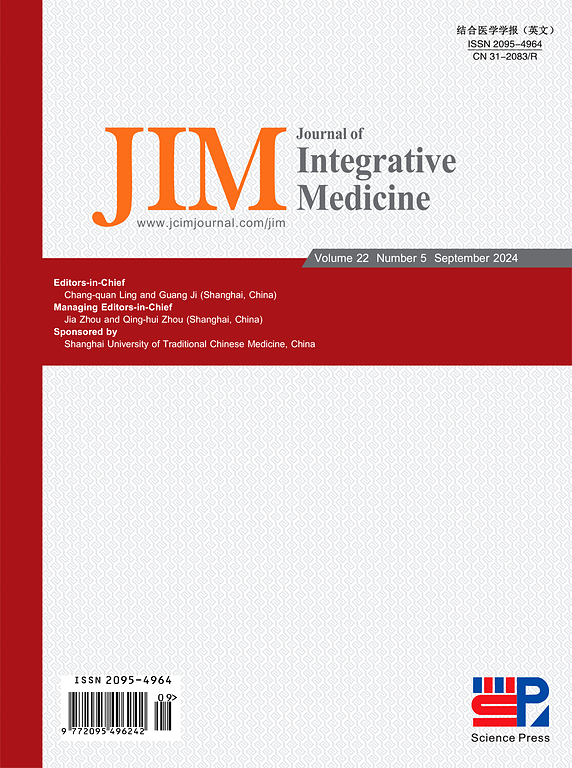Huachansu injection enhances anti-colorectal cancer efficacy of irinotecan and alleviates its induced intestinal toxicity through upregulating UGT1A1-OATP1B3 expression in vitro and in vivo
IF 4
2区 医学
Q1 INTEGRATIVE & COMPLEMENTARY MEDICINE
引用次数: 0
Abstract
Objective
Huachansu injection (HCSI), a promising anti-cancer Chinese medicine injection, has been reported to have the potential for reducing the toxicity of chemotherapy and improving the quality of life for colorectal cancer (CRC) patients. The objective of this study is to explore the synergistic and detoxifying effects of HCSI when used in combination with irinotecan (CPT-11).
Methods
To investigate the effect of HCSI on anti-CRC efficacy and intestinal toxicity of CPT-11, we measured changes in the biological behavior of LoVo cells in vitro, and anti-tumor effects in LoVo cell xenograft nude mice models in vivo. Meanwhile, the effect of HCSI on intestinal toxicity and the uridine diphosphate-glucuronosyltransferase 1A1 (UGT1A1) expression was investigated in the CPT-11-induced colitis mouse model. Subsequently, we measured the effect of HCSI and its 13 constituent bufadienolides on the expression of UGT1A1 and organic anion transporting polypeptides 1B3 (OATP1B3) in HepG2 cells.
Results
The combination index (CI) results showed that the combination of HCSI and CPT-11 exhibited a synergistic effect (CI < 1), which significantly suppressing the LoVo cell migration, enhancing G2/M and S phase arrest, and inhibiting tumor growth in vivo. Additionally, the damage to intestinal tissues was attenuated by HCSI in CPT-11-induced colitis model, while the increased expression of UGT1A1 in HepG2 cells and in mouse was observed.
Conclusion
The co-therapy with HCSI alleviated the intestinal toxicity induced by CPT-11 and exerted an enhanced anti-CRC effect. The detoxifying mechanism may be related to the increased expression of UGT1A1 and OATP1B3 by HCSI and its bufadienolides components. The findings of this study may serve as a theoretical insights and strategies to improve CRC patient outcomes. Please cite this article as: Jiang B, Meng ZY, Hu YJ, Chen JJ, Zong L, Xu LY, Zhang XQ, Zhang JX, Han YL. Huachansu injection enhances anti-colorectal cancer efficacy of irinotecan and alleviates its induced intestinal toxicity through upregulating UGT1A1-OATP1B3 expression in vitro and in vivo. J Integr Med. 2025; 23(5):576–590.
花肠素注射液通过上调体外和体内UGT1A1-OATP1B3表达,增强伊立替康抗结直肠癌的疗效,减轻其诱导的肠道毒性。
目的:花脓素注射液(HCSI)是一种很有前景的抗癌中药注射剂,有可能降低结直肠癌(CRC)患者的化疗毒性,提高患者的生活质量。本研究的目的是探讨HCSI与伊立替康(CPT-11)联合使用时的协同和解毒作用。方法:为了研究HCSI对CPT-11抗crc疗效和肠道毒性的影响,我们在体外检测了LoVo细胞生物学行为的变化,并在体内检测了LoVo细胞异种移植裸鼠模型的抗肿瘤作用。同时,在cpt -11诱导的结肠炎小鼠模型中,研究HCSI对肠道毒性和尿苷二磷酸-葡萄糖醛酸糖基转移酶1A1 (UGT1A1)表达的影响。随后,我们测量了HCSI及其13种成分蟾二烯内酯对HepG2细胞中UGT1A1和有机阴离子转运多肽1B3 (OATP1B3)表达的影响。结果:联合指数(CI)结果显示HCSI与CPT-11联合治疗具有协同作用(CI)结论:HCSI联合治疗可减轻CPT-11引起的肠道毒性,增强抗crc作用。解毒机制可能与HCSI及其蟾二烯内酯成分增加UGT1A1和OATP1B3的表达有关。本研究结果可作为改善结直肠癌患者预后的理论见解和策略。姜波,bbbzy,胡玉军,陈建军,宗丽,徐丽丽,张晓青,张建新,韩玉玲。花肠素注射液通过上调伊立替康体内外UGT1A1-OATP1B3的表达,增强伊立替康抗结直肠癌的疗效,减轻其诱导的肠道毒性。集成医学[J];打印前Epub。
本文章由计算机程序翻译,如有差异,请以英文原文为准。
求助全文
约1分钟内获得全文
求助全文
来源期刊

Journal of Integrative Medicine-Jim
Medicine-Complementary and Alternative Medicine
CiteScore
9.20
自引率
4.20%
发文量
3319
期刊介绍:
The predecessor of JIM is the Journal of Chinese Integrative Medicine (Zhong Xi Yi Jie He Xue Bao). With this new, English-language publication, we are committed to make JIM an international platform for publishing high-quality papers on complementary and alternative medicine (CAM) and an open forum in which the different professions and international scholarly communities can exchange views, share research and their clinical experience, discuss CAM education, and confer about issues and problems in our various disciplines and in CAM as a whole in order to promote integrative medicine.
JIM is indexed/abstracted in: MEDLINE/PubMed, ScienceDirect, Emerging Sources Citation Index (ESCI), Scopus, Embase, Chemical Abstracts (CA), CAB Abstracts, EBSCO, WPRIM, JST China, Chinese Science Citation Database (CSCD), and China National Knowledge Infrastructure (CNKI).
JIM Editorial Office uses ThomsonReuters ScholarOne Manuscripts as submitting and review system (submission link: http://mc03.manuscriptcentral.com/jcim-en).
JIM is published bimonthly. Manuscripts submitted to JIM should be written in English. Article types include but are not limited to randomized controlled and pragmatic trials, translational and patient-centered effectiveness outcome studies, case series and reports, clinical trial protocols, preclinical and basic science studies, systematic reviews and meta-analyses, papers on methodology and CAM history or education, conference proceedings, editorials, commentaries, short communications, book reviews, and letters to the editor.
Our purpose is to publish a prestigious international journal for studies in integrative medicine. To achieve this aim, we seek to publish high-quality papers on any aspects of integrative medicine, such as acupuncture and traditional Chinese medicine, Ayurveda medicine, herbal medicine, homeopathy, nutrition, chiropractic, mind-body medicine, taichi, qigong, meditation, and any other modalities of CAM; our commitment to international scope ensures that research and progress from all regions of the world are widely covered. These ensure that articles published in JIM have the maximum exposure to the international scholarly community.
JIM can help its authors let their papers reach the widest possible range of readers, and let all those who share an interest in their research field be concerned with their study.
 求助内容:
求助内容: 应助结果提醒方式:
应助结果提醒方式:


